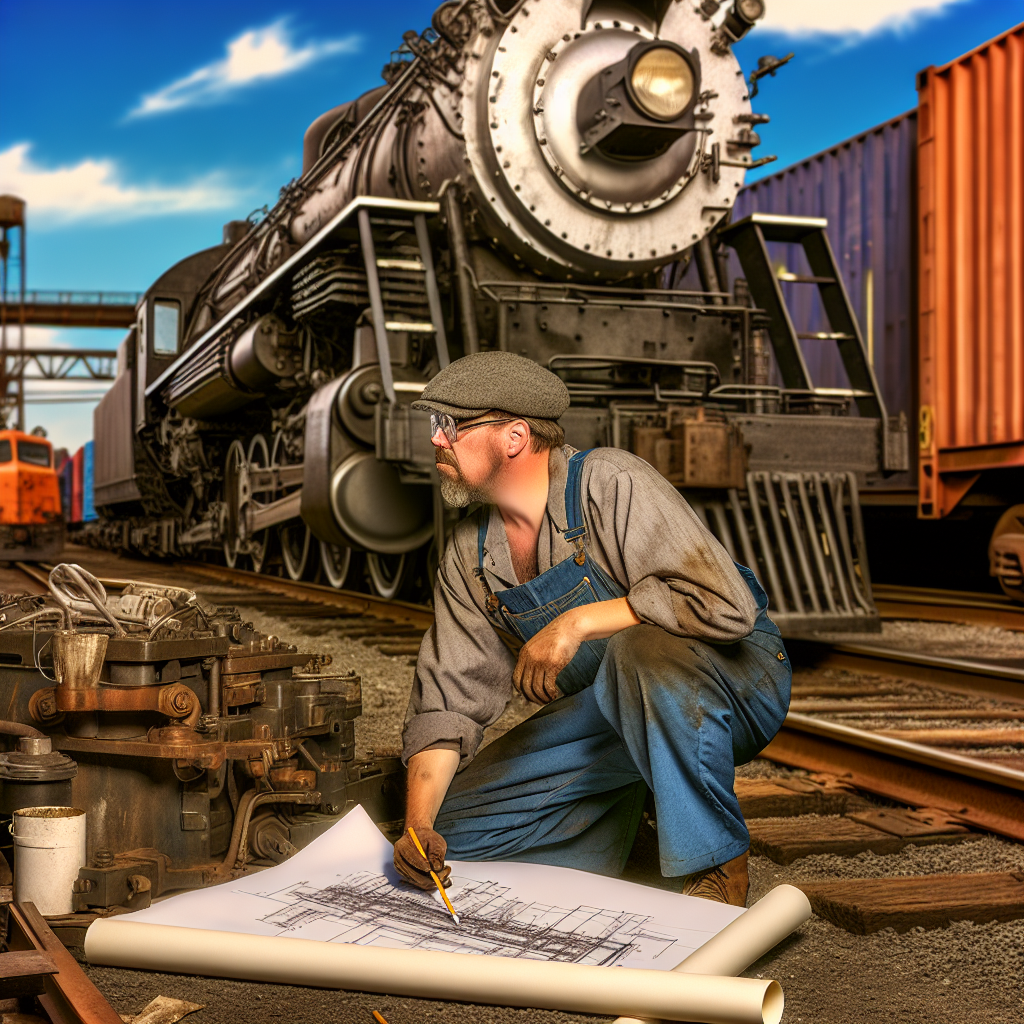Introduction:
Rail yard engineering plays a crucial role in the transportation industry.
Currently, challenges include optimizing space and increasing efficiency.
However, there are numerous opportunities for innovation and improvement in this field.
Rail yard engineering is essential for the smooth functioning of transportation networks.
Efforts are being made to integrate new technologies to modernize rail yards.
Improving safety protocols and reducing environmental impact are also key objectives.
Innovations such as automation and digitization are transforming rail yard operations.
Furthermore, the use of AI and IoT can enhance monitoring and maintenance processes.
Overall, the future of rail yard engineering looks promising with ongoing advancements.
Collaboration between industry stakeholders is vital for driving these innovations forward.
History of rail yard engineering:
- Discussion of the evolution of rail yard design and construction.
- Impact of technological advancements on rail yard engineering practices.
Rail yard engineering has a rich history that dates back to the early days of the railroad industry.
In the early 19th century, rail yards were simple and rudimentary, consisting of basic tracks and a few buildings to service locomotives and rolling stock.
Evolution of rail yard design and construction:
- In the mid-19th century, rail yard engineering began to evolve rapidly.
- Railway companies started to invest in larger and more complex yards.
- New technologies such as turntables and roundhouses revolutionized the way railways operated.
- By the late 19th century, rail yards were vital hubs of activity, facilitating the movement of goods and passengers across the country.
The impact of technological advancements on rail yard engineering practices cannot be understated.
The introduction of diesel and electric locomotives in the 20th century transformed the way rail yards were designed and operated.
Technological advancements in rail yard engineering:
- Automation and computerization have revolutionized rail yard operations.
- GPS tracking and RFID technology have improved efficiency and safety.
- State-of-the-art signaling systems have reduced the risk of accidents.
- Advancements in materials and construction techniques have led to more durable and sustainable rail yards.
As we look ahead to the future of rail yard engineering, several key innovations are on the horizon.
One of the most exciting developments is the advent of autonomous trains.
These trains will be able to operate without human intervention, leading to increased efficiency and safety in rail yard operations.
Innovations ahead in rail yard engineering:
- Implementation of machine learning algorithms to optimize rail yard operations.
- Integration of IoT devices for real-time monitoring and maintenance.
- Development of smart infrastructure to improve connectivity and communication.
- Exploration of alternative fuel sources such as hydrogen fuel cells for locomotives.
The future of rail yard engineering is bright and full of possibilities.
With continued advancements in technology and innovation, we can expect to see more efficient, sustainable, and safe rail yards.
These advancements will play a crucial role in shaping the future of transportation.
Transform Your Career Today
Unlock a personalized career strategy that drives real results. Get tailored advice and a roadmap designed just for you.
Start NowCurrent Trends in Rail Yard Engineering
As we look towards the future of rail yard engineering, it’s important to understand the current trends shaping the industry.
From exploring innovative technologies to successful case studies, here’s a closer look at what’s happening in rail yard design today.
Exploration of Current Innovations
- Implementation of AI and machine learning in yard operations
- Utilization of IoT sensors for real-time monitoring of assets
- Integration of automated systems for increased efficiency
- Development of advanced analytics for predictive maintenance
- Adoption of digital twins for improved planning and simulation
These innovations are revolutionizing the way rail yards are designed, operated, and maintained.
By leveraging cutting-edge technologies, engineers can optimize processes and enhance overall performance.
Case Studies of Successful Projects
- Union Pacific’s use of drone technology for track inspections
- Canadian National Railway’s implementation of RFID for inventory management
- CN Rail’s deployment of autonomous robots for yard operations
- BNSF Railway’s adoption of laser scanning for infrastructure assessments
- CSX Transportation’s integration of blockchain for supply chain transparency
These case studies highlight the tangible benefits of incorporating advanced engineering solutions in rail yard projects.
By showcasing successful implementations, industry professionals can learn from real-world examples and drive innovation forward.
The current trends in rail yard engineering are pushing the boundaries of what is possible in the industry.
Engineers are shaping the future of rail yard design and operations by embracing innovation and constantly evolving.
Find Out More: Distribution Management Trends to Watch in 2025
Environmental Sustainability in Rail Yard Engineering
In recent years, the focus on environmental sustainability in rail yard engineering has gained significant traction.
The need to reduce carbon emissions, conserve resources, and minimize environmental impact has driven the industry to explore new approaches and technologies.
Role of Sustainability Practices in Rail Yard Design
Sustainability practices play a crucial role in the design of modern rail yards.
By incorporating environmentally friendly initiatives into the planning and construction phases, engineers can create more efficient and eco-friendly facilities.
This includes:
- Optimizing layout and design to reduce energy consumption
- Implementing green infrastructure for stormwater management
- Utilizing recycled materials for construction
These practices not only help minimize the environmental footprint of rail yards but also contribute to cost savings and long-term sustainability.
Green Initiatives in Rail Yard Construction
Rail yard construction is a complex process that requires careful consideration of environmental impacts.
Green initiatives can help mitigate these effects and promote sustainability in the following ways:
- Installation of solar panels to reduce energy consumption
- Use of permeable pavements for improved stormwater infiltration
- Integration of green spaces to enhance biodiversity
By adopting these environmentally friendly approaches, rail yard engineers can create more efficient and sustainable facilities that benefit both the environment and the community.
The future of rail yard engineering lies in embracing sustainability practices and incorporating green initiatives into every aspect of design and construction.
By prioritizing environmental stewardship, the industry can pave the way for a more sustainable and eco-friendly future.
Transform Your Career Today
Unlock a personalized career strategy that drives real results. Get tailored advice and a roadmap designed just for you.
Start NowDiscover More: Freight Broker Load Boards: How They Work and Benefits
Digitalization and automation in rail yard engineering:
With the advent of digital tools and automation, rail yard operations are undergoing a significant transformation.
Let’s delve into how these innovations are reshaping the future of rail yard engineering.
Analysis of how digital tools and automation are transforming rail yard operations:
- One of the key aspects of digitalization in rail yard engineering is the implementation of IoT (Internet of Things) devices.
- These devices allow for real-time monitoring of equipment and infrastructure, leading to improved efficiency and operational safety.
- Automation technologies such as robotics and autonomous vehicles are also revolutionizing the way tasks are carried out in rail yards.
- By automating repetitive and mundane tasks, rail yard operators can focus on more critical aspects of yard management.
- Digital twin technology is another innovation that is gaining traction in rail yard engineering.
- It involves creating a virtual replica of the physical rail yard, enabling predictive maintenance and optimization of operations.
Examples of how data analytics and artificial intelligence are being used to optimize rail yard performance:
- Advanced data analytics tools are being utilized to analyze historical data and identify patterns in rail yard operations.
- By leveraging predictive analytics, rail yard operators can anticipate equipment failures and schedule maintenance proactively.
- Artificial intelligence algorithms are being deployed to optimize rail yard layouts and improve traffic flow within yards.
- Machine learning algorithms are also used to predict demand patterns and optimize inventory levels in rail yards.
- Through the integration of AI-powered systems, rail yard operators can make data-driven decisions to enhance overall efficiency.
Digitalization and automation are revolutionizing the field of rail yard engineering.
By embracing these innovations, rail yard operators can enhance operational efficiency, ensure safety, and pave the way for a more sustainable future in rail transportation.
You Might Also Like: Warehouse Supervisor: Team Building and Morale
Future challenges and opportunities in rail yard engineering:
– Identification of potential obstacles and hurdles the industry may face
– Discussion of emerging technologies and strategies that can shape the future of rail yard engineering
Rail yard engineering is a critical aspect of the transportation industry that is constantly evolving to meet the demands of an ever-changing world.
As we look ahead to the future, there are several challenges and opportunities that await the industry.
One of the potential obstacles that rail yard engineering may face in the future is the increasing need for sustainability and environmental responsibility.
As concerns about climate change and environmental impact continue to grow, the industry will need to find ways to reduce its carbon footprint and incorporate more eco-friendly practices into its operations.
Additionally, with the rise of automation and digitalization, there will be a need for rail yard engineers to adapt to new technologies and strategies to streamline operations and increase efficiency.
This shift towards automation presents both challenges and opportunities for the industry.
It will require a new skill set for engineers while also offering the potential for increased productivity and cost savings.
Emerging technologies such as artificial intelligence, Internet of Things (IoT), and advanced analytics are already beginning to shape the future of rail yard engineering.
These technologies have the potential to revolutionize how rail yards operate, from predictive maintenance and asset tracking to real-time optimization of train movements and scheduling.
Furthermore, the use of drones for inspection and monitoring purposes is becoming increasingly common in the industry.
This provides a new level of efficiency and safety for rail yard operations.
By utilizing drones, engineers can quickly and accurately assess the condition of tracks, bridges, and other infrastructure.
Transform Your Career Today
Unlock a personalized career strategy that drives real results. Get tailored advice and a roadmap designed just for you.
Start NowThis allows for faster and more informed decision-making.
In addition to technological advancements, strategies such as lean principles and continuous improvement are becoming more prevalent in rail yard engineering.
By implementing lean practices, rail yards can reduce waste, improve efficiency, and enhance overall performance.
Continuous improvement efforts ensure that processes are constantly being evaluated and optimized for maximum effectiveness.
As the industry continues to evolve, collaboration between stakeholders will be crucial for overcoming challenges and maximizing opportunities in rail yard engineering.
By working together to share knowledge, resources, and best practices, engineers can ensure that the future of rail yard engineering is sustainable, efficient, and innovative.
Explore Further: Warehouse Supervisor: Dealing with High Turnover Rates

Urbanization Impact on Rail Yard Engineering
Urbanization has a significant impact on rail yard engineering due to various factors.
Overview of Urban Growth Influence on Rail Yard Design
As cities grow, the demand for efficient transportation systems increases.
This leads to the need for well-designed rail yards.
Population growth in urban areas results in higher demand for goods.
This necessitates the expansion and modernization of rail yard facilities.
The proximity of rail yards to urban centers requires careful planning.
This planning aims to minimize noise, pollution, and traffic congestion.
Rail yard design must consider integration with existing urban landscapes.
This ensures minimal disruption while supporting urban growth.
Innovative Solutions for Integrating Rail Yards into Urban Landscapes
One approach is utilizing advanced technologies such as automated systems.
Robotics can improve efficiency and reduce environmental impact.
The use of underground or elevated rail yards helps minimize the footprint.
This strategy allows for more efficient land use within urban areas.
Transform Your Career Today
Unlock a personalized career strategy that drives real results. Get tailored advice and a roadmap designed just for you.
Start NowIntegrating green spaces and eco-friendly designs promotes sustainability.
Such designs enhance the aesthetic appeal of the surrounding environment.
Collaboration between urban planners, architects, and engineers is crucial.
They develop solutions that blend rail yards with urban infrastructure harmoniously.
The impact of urbanization on rail yard engineering requires innovative solutions.
These solutions address the growing demand for efficient transportation systems.
They also aim to minimize negative effects on urban environments.
Collaboration and partnerships in rail yard engineering:
- Importance of collaboration between industry stakeholders, government agencies, and communities
- Case studies of successful partnerships that have enhanced rail yard infrastructure and operations
The Role of Collaboration in Rail Yard Engineering
Collaboration is the key to success in the future of rail yard engineering.
It involves bringing together industry stakeholders, government agencies, and communities to work towards a common goal of improving rail yard infrastructure and operations.
By working together, these stakeholders can pool their resources, knowledge, and expertise to address challenges and implement innovative solutions in the industry.
Benefits of Collaboration
Collaboration in rail yard engineering offers several benefits.
It allows for the sharing of best practices, technologies, and resources among different parties, leading to more efficient and cost-effective solutions.
By leveraging the collective expertise of diverse stakeholders, collaboration can help drive innovation and create sustainable outcomes for the industry.
Successful Partnerships in Rail Yard Engineering
Several case studies highlight the success of partnerships in enhancing rail yard infrastructure and operations.
For example, a partnership between a rail yard operator and a technology company resulted in the implementation of an automated rail yard system, significantly improving efficiency and reducing operational costs.
Another partnership between a government agency and a community group led to the development of a rail yard that prioritized environmental sustainability and community engagement.
Lessons Learned from Successful Collaborations
From these case studies, we can learn valuable lessons about the importance of collaboration and partnerships in rail yard engineering.
Communication, trust, and shared goals are essential elements for successful collaborations.
Transparency and open dialogue among stakeholders can help build strong relationships and foster innovation in the industry.
Looking Towards the Future
As we look to the future of rail yard engineering, collaboration and partnerships will continue to play a crucial role in driving innovation and sustainable development.
Transform Your Career Today
Unlock a personalized career strategy that drives real results. Get tailored advice and a roadmap designed just for you.
Start NowBy working together, industry stakeholders, government agencies, and communities can create a more interconnected and efficient rail yard ecosystem that meets the needs of the present and future generations.
Innovations in Rail Yard Engineering
In this blog post, we explored the future of rail yard engineering and the exciting innovations that lie ahead.
From the implementation of smart technologies to the use of sustainable materials, the industry is on the brink of a major transformation.
Reflecting on the potential for continued innovation and progress in rail yard engineering, it is evident that the possibilities are endless.
As technology continues to advance, we can expect to see even more efficient and environmentally friendly solutions being developed.
By focusing on enhancing safety, productivity, and sustainability, rail yard engineering is poised to play a pivotal role in shaping the future of transportation.
It is essential for industry professionals to embrace new ideas and technologies to keep up with the ever-changing landscape.
As we move forward, collaboration between engineers, designers, and manufacturers will be crucial in driving innovation and pushing the boundaries of what is possible in rail yard engineering.
By fostering a culture of creativity and continuous improvement, we can ensure that the industry remains at the forefront of progress.
The future of rail yard engineering is bright, with endless opportunities for growth and development.
By staying ahead of the curve and embracing new innovations, we can create a more sustainable and efficient transportation network for generations to come.
Additional Resources
Proceedings of FRA Workshops on Environmentally Sustainable …
4 Reasons Why Ohio Is a Logistics Hub | EASE Logistics
[E-Books for Sale]
The Big Book of 500 High-Paying Jobs in America: Unlock Your Earning Potential
$19.99 • 500 High-Paying Jobs • 330 pages
Explore 500 high-paying jobs in America and learn how to boost your career, earn more, and achieve success!
See All 500 High-Paying Jobs of this E-Book
1001 Professions Without a Degree: High-Paying American Jobs You Can Start Now
$19.99 • 1001 Professions Without a Degree • 174 pages
Discover 1001 high-paying jobs without a degree! Unlock career tips, skills, and success strategies for just $19.99!




